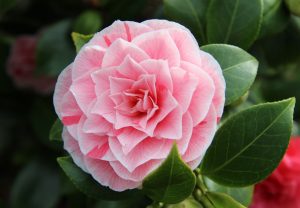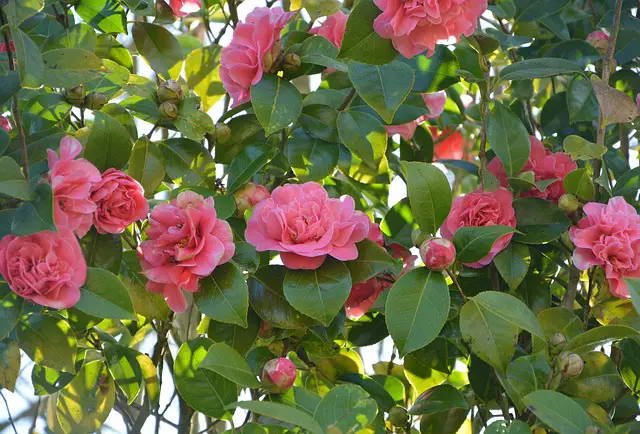Last Updated on April 15, 2024 by Real Men Sow
Camellias are beautiful shrubs that produce stunning flowers in Autumn and early Summer. The most common camellia problems are due to poor growing conditions. There are also a few pest and disease issues that can affect your camellias which we will go through in this post. It is important to pinpoint the problem area so you can narrow down the list to the most likely one to affect your camellia plants.

Most Common Camellia Problem: Camellias Are Not Flowering and Bud Dropping
Camellias are most often plagued by problems with their flowers. The most common problem with camellias is the loss of flower buds. This is usually caused by poor conditions, such as dry soil, lack of soil, or morning sun. It is important to protect your plants with horticultural fleece or bubble wrap during winter to prevent them from falling victim to this.
Not Enough Sun
This could also be due to the insufficient sun. If your plant is placed in an area that gets too much shade, this could cause it to fail. For best results, it is important to give your plant sun in the morning and dappled shade during the afternoon. They need to be able to get some shade during the day if they aren’t getting morning sun.
Problems with Camellia Roots
Honey Fungus or Phytophthora Root
Root decay can be detected by digging down to the base of the plant. Root disease can cause this. Phytophthora root rot and honey fungus are the most common. This is more common in container-grown plants.
Waterlogging Leading to Root Rot
Waterlogging is the main cause of root decay, it can occur in container-grown plants that have insufficient drainage, or when the potting soil loses its structure. However, it can also happen in plants grown in the ground in moist soils. It is best to repot container-grown plants promptly to prevent root binding. However, it is important to avoid learn how much water is enough for plants.
Root death of Container-grown Plants from Winter Frost
Another possible cause could be the weather and prolonged frost. Container-grown plants in the UK can be severely affected by harsh winters. Roots freeze when there is a hard frost. To prevent this, wrap your containers in horticultural fleece and bubble wrap to keep them warm.
Vine Weevil Grubs Eating the Roots
Vine Weevil attacks can be detected if your Camellia shows fewer roots or white grubs when it is repotted. This is a common problem with container-grown plants. The larvae feed on the roots, and the adult beetles eat the leaves leaving tiny holes.
More Camellia Problems: Check the Back of Stems and Branches
If you notice the branches are dying, it is likely that there are root problems. Branch dieback occurs when the roots aren’t able to absorb enough water. You should be aware of any problems in the roots and examine them for signs that may indicate the root cause.
Leaf Blight on Camellias
Leaf blight can also cause branch death. Before you dig into the roots, take a look at all the leaves of your Camellia. The problem with the leaves will likely be apparent before it affects the stems.
Camellia Problems that Affect Leaves
Camellias are an evergreen plant which means they are usually green throughout the year, but can shed some old leaves from time to time. It is normal for some leaves to turn yellow or fall off during spring and summer. Colour is the real problem, different colors indicate different problems.
Camellia Leaves Starting to turn Yellow
You might notice the yellowing of the Camellia leaves as you work your way up to the ends. It can be a sign of many problems, so it is important to know what the cause of this yellowing can be. It could be indicative of root problems. This is typically only true if the entire plant shows yellowing.
Nutrient Deficiency Causing Camellia Leaves to Turn Yellow
Yellowing in the veins of the leaves can indicate a nutrient shortage. Camellias can be classified as acid-loving plants. You can cause yellowing of the leaves if you use the wrong kind of fertilizer or have the wrong soil. It is recommended to grow your Camellia in an alkaline soil container. This will allow you to use ericaceous, which provides the acidic environment essential for camellias. Acidic fertilizers should be applied in spring after flowering, and every few weeks during the summer.
Yellow Blotches or Creamy White Blotches caused by Yellow Mottled Virus
If your leaves have yellow spots or creamy white spots, this is a sign of yellow mottled virus infection. This infection is not preventable. However, you can prune the affected branches. It does not affect flower or plant growth.
Why Are Camellias Leaves Turning Brown?
The answer is drought, cold winds in winter, and leaf blight. The browning of the leaves could be due to many factors, most of which aren’t too serious. This could be the end stages of root rot, which can be a problem. You may need to improve drainage or repot container-grown plants. It could also be caused by leaf blight fungal infections.
When the leaves are subject to severe drought, wind damage or frost, it is most likely that they will turn brown. It’s not only winter that can affect your plant. Keep the soil moist in dry weather, and place your plant in a protected area away from cold winds to prevent this. You might notice large brown spots on your leaves during a heatwave. These are not burnt areas from high temperatures. They always heal but the leaves often fall first.
Leaves on Camellias getting Brown Spots
If the browning is occurring in patches, it could be a fungal disease. In more severe cases, the fungal infection may spread the length of the branch to cause branch dieback. Any inspected leaves should be removed as soon as possible. This will stop the disease from spreading to other parts of your plant.
Black Mound on Camellias Leaves caused by Sooty Mould
The black spots on your leaves are caused by a sooty mold fungus, which is in itself harmless but unattractive. These are usually left over sap-sucking insects that have stripped the leaves of their sap and left behind sticky honeydew. You should inspect the underside of your leaf for any small brown scales. This isn’t a problem for the plant, and can be washed off. However, you need to make sure it doesn’t reappear.
Some Leaves on Camellias have turned White and become Swollen
Camelia Gall is a fungal disease that causes leaves to swell and turn white. Camelia Gall is a fungal disease that is not only unsightly, but also does not pose a threat to the overall health and well-being of your plant. It is important to remove the affected leaves as soon as you notice it.
Once you have a list of common problems, it is important to identify the affected part and narrow down the list to find the best solution. This will ensure that your plants grow strong and healthy.


